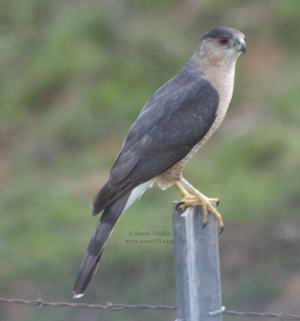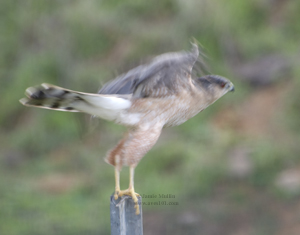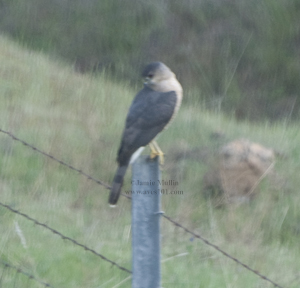Sharp-shinned Hawk
Order: Falconiformes
Family: Accipitridae
Genus: Accipiter
Species: striatus
**audio comming soon**
Description
-
Length: 11"
-
Wing span: 23"
-
Weight: 5.0 oz (140 grams)
-
Small hawk similar in size to a Magpie
-
Tail is long, barred, and the tip of the tail is squared
-
Wings are short and rounded
-
Blue-gray back and wings with reddish barred underparts
-
Red eyes and white undertail coverts
-
Sexes are silimar in plumage with females being substantially larger
-
Juveniles are brown on back and wings with coarse brown streaks on underparts. Underwings are white with dark brown barring. Thin white eyestripe and yellow eyes
Factoids:
- A small hawk, the Sharp-shinned Hawk is a regular visitor to bird feeders, where it eats birds, not seed. The male and female show a greater disparity in size than any other American hawk; the female is nearly twice the weight of the male
- After the young leave the nest, the adults pass food to the young in mid-air. The parents give the prize to the first young hawk to reach them, hovering briefly and kicking the prey outward just as the fledgling arrives
- Sharp-shinned Hawk numbers declined during the DDT pesticide years (mid-1940s to 1972), but rebounded after DDT was banned
- Sharp-shinned Hawks migrate south out of Canada in the fall and are observed at hawk watches in very large numbers. The hawks follow similar landscape features and often are concentrated in certain areas. Over 11,000 Sharp-shinned Hawks were seen on one October day at Cape May Point, New Jersey
- The habit of hunting around bird feeders has been suggested as an explanation for the decrease in numbers of Sharp-shinned Hawks seen at eastern hawk watches. Fewer hawks may be migrating south, preferring instead to stay farther north near a dependable food source: feeder birds
- The Coopers Hawk is extremely similar to this species. The main difference is the size. A Sharp-shinned Hawk is roughly the size of a Magpie
All photographs and audio clips are ©Jamie Mullin 2006
Sources: Cornell Lab of Ornithology & The Sibley Guide to Birds.
 |
|---|
 |
 |
 |
 |